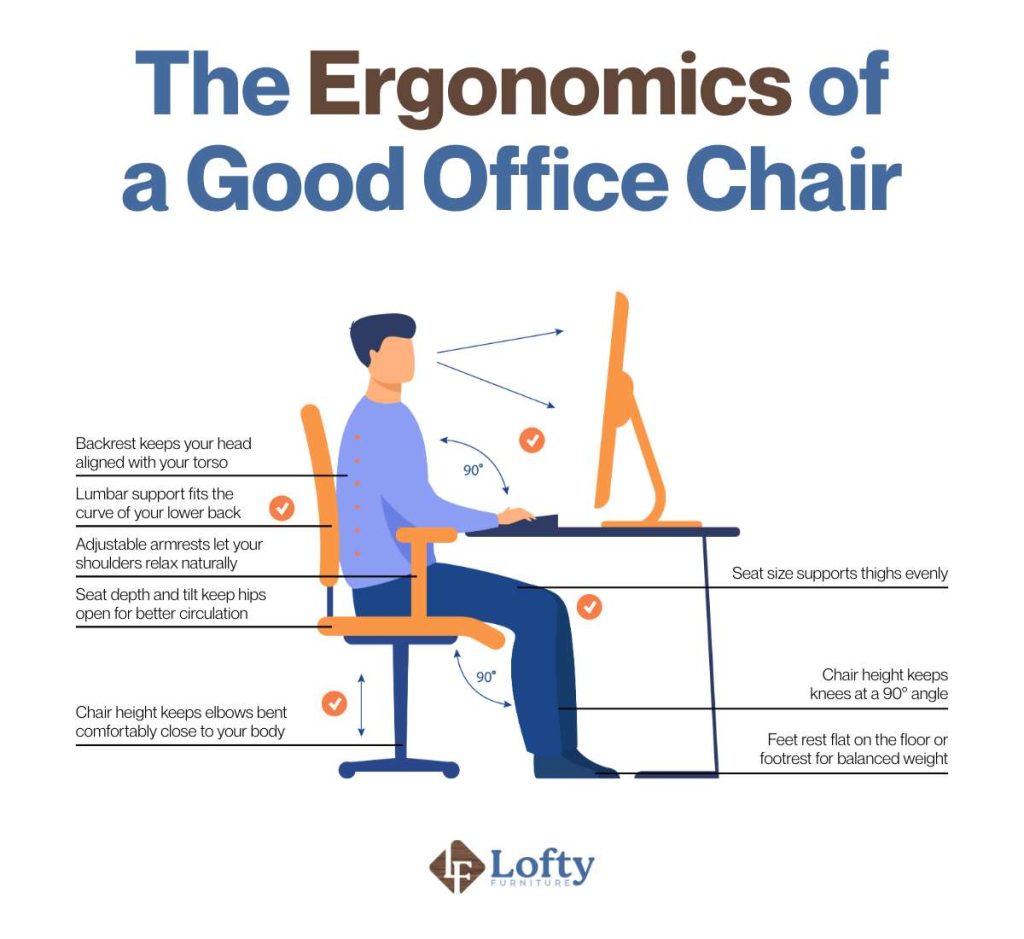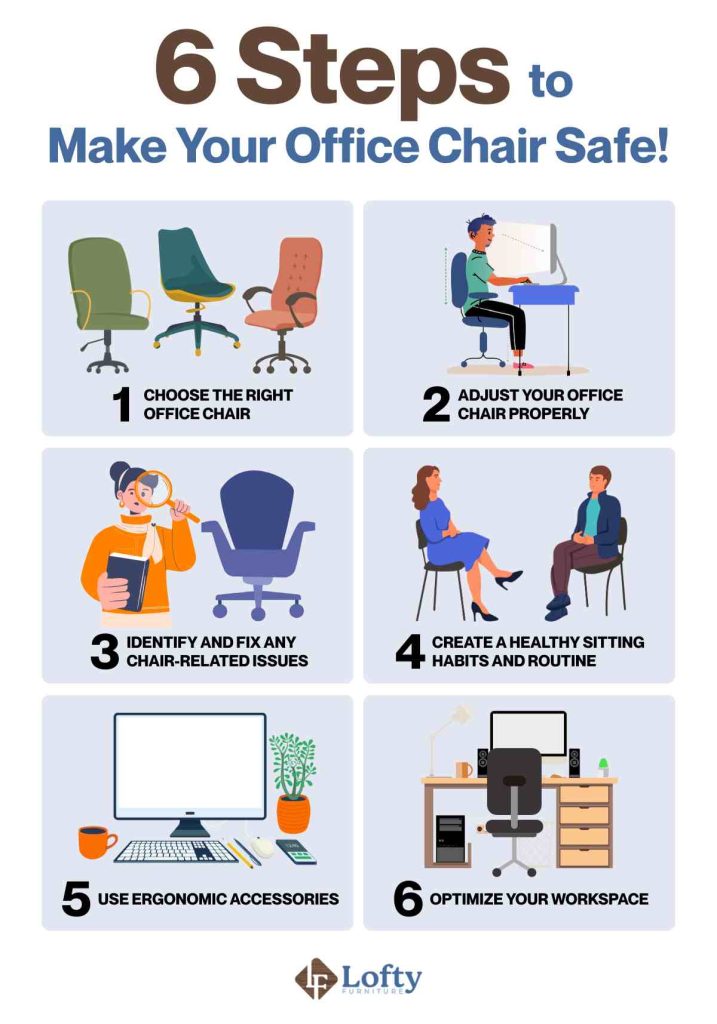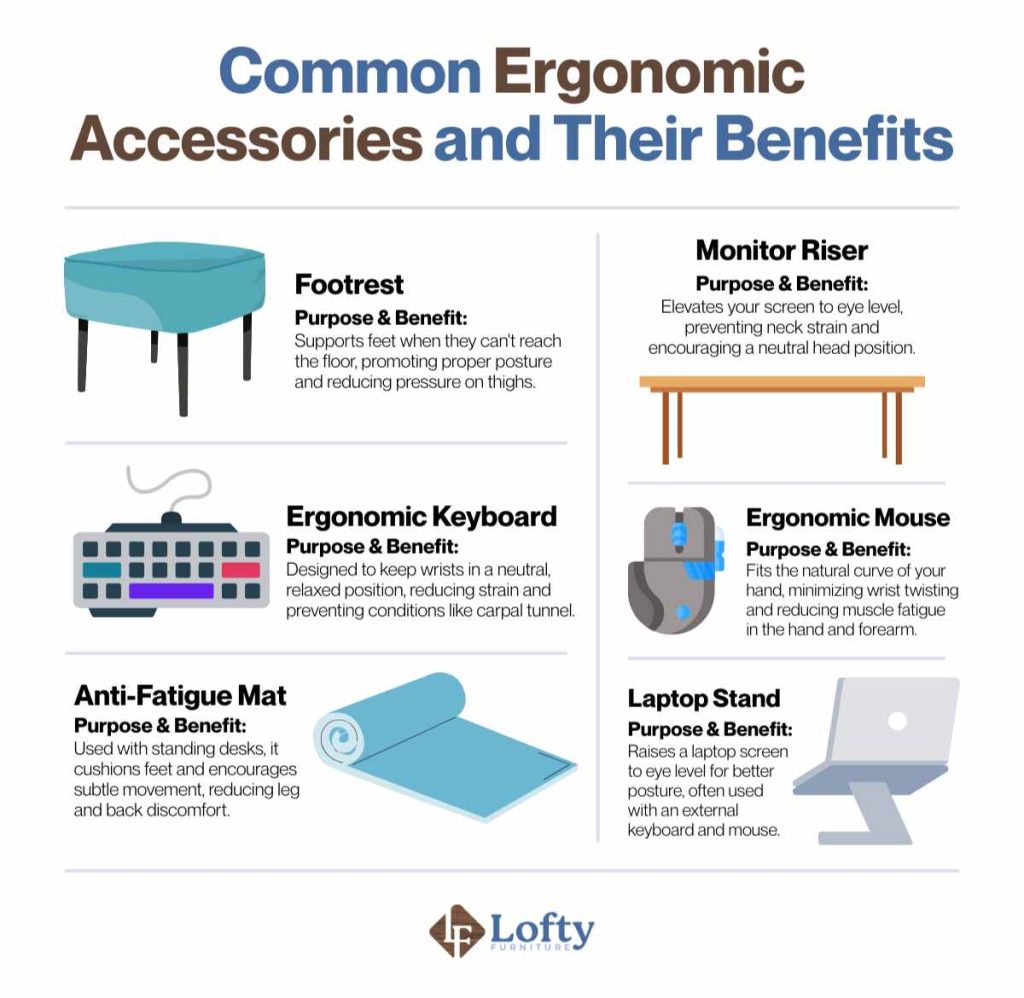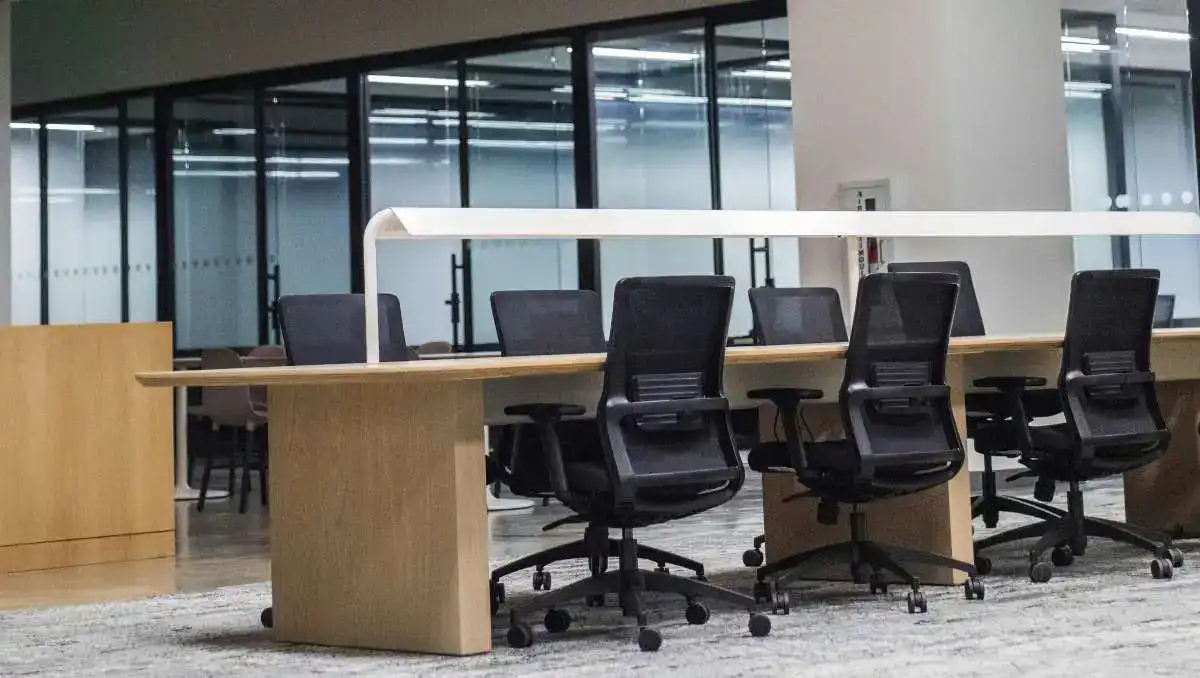Spending hours each day in an office chair, whether at a desk or in meetings, has become a normal part of many people’s routines. But what if the chair that’s meant to provide comfort is actually contributing to health issues like back pain and poor posture? Office chairs, while designed for support, can sometimes do more harm than good.
Key Takeaways:
- Office chairs are dangerous and can pose health risks when used improperly.
- To make your office chair safe, you must choose the right office chair, adjust it properly, create healthy sitting habits, use ergonomic accessories, and optimize your workspace.
- A good office chair should promote proper spine alignment and is customizable to fit your unique body shape.
In this article, we will explore the topic of office chair safety and provide valuable information on mitigating these risks.
The Ergonomics of A Good Office Chair
A good office chair should support healthy posture by keeping your spine in its natural S-curve, reducing strain on your back and neck. Lumbar support is especially important — adjustable options let you fit the chair to your body, helping prevent lower back pain and issues like sciatica.
Adjustable armrests, seat height, and tilt mechanisms also make a big difference, allowing you to fine-tune the chair for your comfort and body proportions. When your chair is set up to support you well, it not only protects your health but also makes it easier to stay focused and productive throughout the day.

Potential Dangers Associated with Office Chairs
Office chairs can pose potential dangers to your health in several ways. The design of the chair, specifically its impact on your back, can contribute to chronic back pain.

Back Pain, Posture, and Musculoskeletal Health
The design of an office chair plays a crucial role in maintaining good posture and preventing discomfort. A lack of proper lumbar support, adjustable armrests, or adequate seat cushioning can lead to strain on the spine and back pain over time. When the lower back isn’t properly supported, it often causes slouching or hunching forward, which puts extra pressure on the neck, shoulders, and spine. This poor posture can result in muscle imbalances, stiffness, and long-term chronic pain.
Circulation Issues and Blood Clot Risks
Sitting for prolonged periods in a poorly designed chair doesn’t just affect posture; it can also impact circulation. Stagnant blood flow can increase the risk of blood clots in the legs, further complicating health problems associated with poor seating. Inadequate office chairs may also contribute to musculoskeletal disorders, which can lead to discomfort and long-term issues like neck, shoulder, and back pain. Research indicates that these issues can severely affect both physical health and productivity.
Long-term Consequences of Using Inadequate Office Chairs
Using an uncomfortable or inadequate office chair can have long-lasting effects on both physical and mental health. Studies, including a report by Leeds Metropolitan University, show that chronic pain from poorly designed seating can lead to mental health problems, decreased productivity, and overall quality of life. According to office specialist Louise Shipley, workplace ergonomics are essential for employees to perform at their best. Businesses must recognize this and take steps to ensure that employees’ health is not negatively impacted.
The Danger of Office Chair Malfunctions
Another danger to consider is the potential risk of an office chair malfunction. Many office chairs use a gas lift cylinder to adjust height, but if this cylinder becomes compromised, it can lead to a dangerous release of pressure. This can cause what’s known as an “office chair explosion,” a potentially harmful incident that underscores the importance of proper chair maintenance.
Factors Influencing Office Chair Safety
When it comes to office chair safety, several factors can influence the level of risk. One key aspect is the quality and design of the chair itself.

Chair Quality and Design
High-quality office chairs are built for both comfort and safety, using most durable materials that withstand daily use while providing long-lasting support. Well-chosen fabrics and finishes resist wear and remain comfortable over time, though prices can vary depending on features and build quality. Checking customer reviews can help you gauge real-world performance and satisfaction. Ultimately, choosing a chair that balances comfort, durability, and safety can make a big difference in your productivity and overall well-being at work.
Personal Habits and Practices
Personal habits and practices play a crucial role in avoiding the dangers associated with office chair use. Firstly, taking regular breaks to stand, stretch, and move around can help alleviate the strain on muscles and joints caused by prolonged sitting.
Maintaining good posture, with the back properly aligned and supported, is essential to prevent back and neck pain. Adjusting the chair to one’s specific ergonomic needs, such as seat height and lumbar support, ensures a comfortable and health-conscious sitting position.
How to Make Your Office Chair Safe
Regarding office chair safety, there are several vital points to keep in mind. Following these tips will help ensure a safe and comfortable work environment.

1. Choose the right office chair.
Look for chairs that offer lumbar support, which helps keep your spine’s natural curvature. Adjustable armrests are crucial for supporting your arms comfortably, preventing shoulder and neck tension. Additionally, opt for a chair with seat height adjustment to position yourself at the optimal height relative to your desk.
2. Adjust your office chair properly.
Adjust the seat height, lumbar support, and armrest position to achieve proper posture. Pay attention also to the chair tilt. The tilt mechanism allows you to lean slightly backward or forward, depending on your preference. Find a comfortable tilt angle that supports both relaxation and productivity.
3. Identify and fix any chair-related issues.
A comfortable and supportive office chair is essential for a productive, pain-free work environment. However, various chair-related issues can compromise your well-being and overall work experience. Recognizing and addressing problems promptly is crucial for maintaining a healthy workspace.
4. Create a Healthy Sitting Routine
Establish a regular schedule of movement breaks and incorporate stretching exercises to keep your body in tip-top shape. Taking regular breaks throughout the day is also crucial. Stand up, walk around, and stretch every hour or so to relieve tension and improve circulation.
Follow these ergonomic guidelines to discover the best way to sit and optimize your workstation:
- First, adjust your chair height so that your feet are flat on the floor and your knees are at a 90-degree angle.
- Maintain proper posture by sitting straight with your back supported by the chair’s backrest.
- Avoid slouching or leaning forward for extended periods.
- Remember to take regular breaks from prolonged sitting to stretch and move around.
5. Use Ergonomic Accessories
Ergonomic accessories, such as lumbar cushions and footrests, can help you maintain proper positioning while seated at your desk. In addition to using ergonomic accessories, consider incorporating alternative seating options into your routine. Swapping out your traditional office chair for an exercise ball or a kneeling chair can engage different muscle groups and promote better posture.

Combat the hidden dangers of prolonged sitting and transform your workday. Explore our range of ergonomic office chairs designed to support your health.
Advances in Ergonomic Chair Technology
Modern office chairs now incorporate smart technologies like pressure sensors, posture tracking, and app-connected reminders that prompt users to adjust their sitting habits. These features encourage movement throughout the day; addressing the dangers of prolonged sedentary behavior. Materials have also evolved, with breathable mesh, adaptive memory foams, and dynamic lumbar systems becoming standard in high-quality models.
Beyond comfort, manufacturers are embracing sustainable design principles. Chairs built with recycled aluminum, biodegradable components, and low-VOC (volatile organic compound) finishes are gaining traction in both home and corporate offices. Additionally, brands are now prioritizing modular designs, allowing users to replace worn-out parts instead of discarding the entire chair—extending lifespan and reducing waste.
Final Note on Optimal Office Chair Safety
In conclusion, office chairs can indeed pose potential dangers if they are not used correctly. However, by following proper ergonomic guidelines and taking regular breaks to stretch, you can significantly reduce the risk of developing posture and musculoskeletal problems.
Remember, your health should always come first. So take a moment to think of your office chair as a vehicle for productivity, but one that requires frequent pit stops for maintenance and adjustments along the way. Your body will thank you in the long run!
Frequently Asked Questions
How often should I stand up or take a break from sitting?
Experts recommend following the 20-8-2 rule: sit for 20 minutes, stand for 8 minutes, and move/stretch for 2 minutes. Even short breaks every 30-60 minutes can significantly reduce the negative impacts of prolonged sitting. The key is frequent movement, not just one long break.
Are standing desks a complete solution to the dangers of sitting?
While a standing desk offer significant benefits by reducing sedentary time, they are not a complete solution on their own. Prolonged standing can also lead to issues like foot pain, varicose veins, and lower back strain. The most effective strategy is to alternate between sitting and standing, adopting a sit-stand approach.
Can a simple cushion fix a bad office chair?
While a good cushion (e.g., memory foam or gel) can offer some temporary relief by improving pressure distribution, it cannot fundamentally correct the design flaws of a poor chair or provide adequate structural support. It’s a band-aid solution; a properly designed ergonomic chair with adjustable features is always superior.
What are the absolute must-have features in an ergonomic office chair?
Key features include: adjustable seat height, seat pan depth (to ensure proper leg support), a backrest that supports the natural curve of your spine (preferably with adjustable lumbar/sacral support), adjustable armrests that allow your arms to be parallel to the floor, and a stable base with smooth-rolling casters. Look for chairs that allow you to customize these elements to your body.
